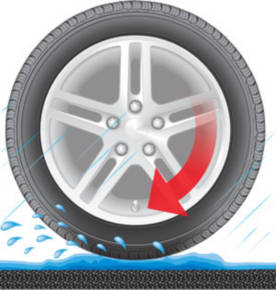Underinflated Tires in Wet Weather
Underinflated tires do not evenly distribute the loads they carry. Loads must be evenly distributed throughout the tire as the center of the tread can't support the weight of the vehicle. When this center tread area can't support the vehicle's weight, the tire's shoulders are forced to pick up the slack, causing the center tread to lift up from the driving surface.
Improper air pressure can lead not only to premature treadwear but also keeps the tire from sufficiently displacing water, making it more likely to hydroplane. Hydroplaning is dangerous and can lead to injury and damage of both driver and vehicle while putting other drivers and pedestrians at risk as well. This means that it is imperative to avoid underinflated tires.

What is the Best Tire Pressure for Traveling in the Rain?
Properly inflated tires evenly distribute loads across the face of the tire, maximizing how much tread contacts the driving surface. This allows full contact with the road, removing water from the contact patch as rapidly as possible.
For the best possible wet weather performance, we recommend inflating your tires to the vehicle manufacturer’s recommended air pressure. This provides the best possible contact patch for your tires.
In addition to wet weather traction, tire pressure also affects treadwear. Discount Tire shows you how to check tire pressure so that you can keep your vehicle as safe as possible.
Do your tires need servicing or maybe your tire pressure is low? Call, drop by or make an appointment and we’ll get you taken care of. Get a shorter wait time in-store when you buy and book online!
